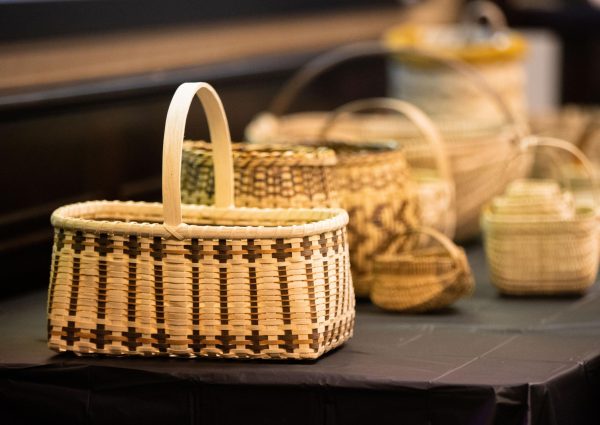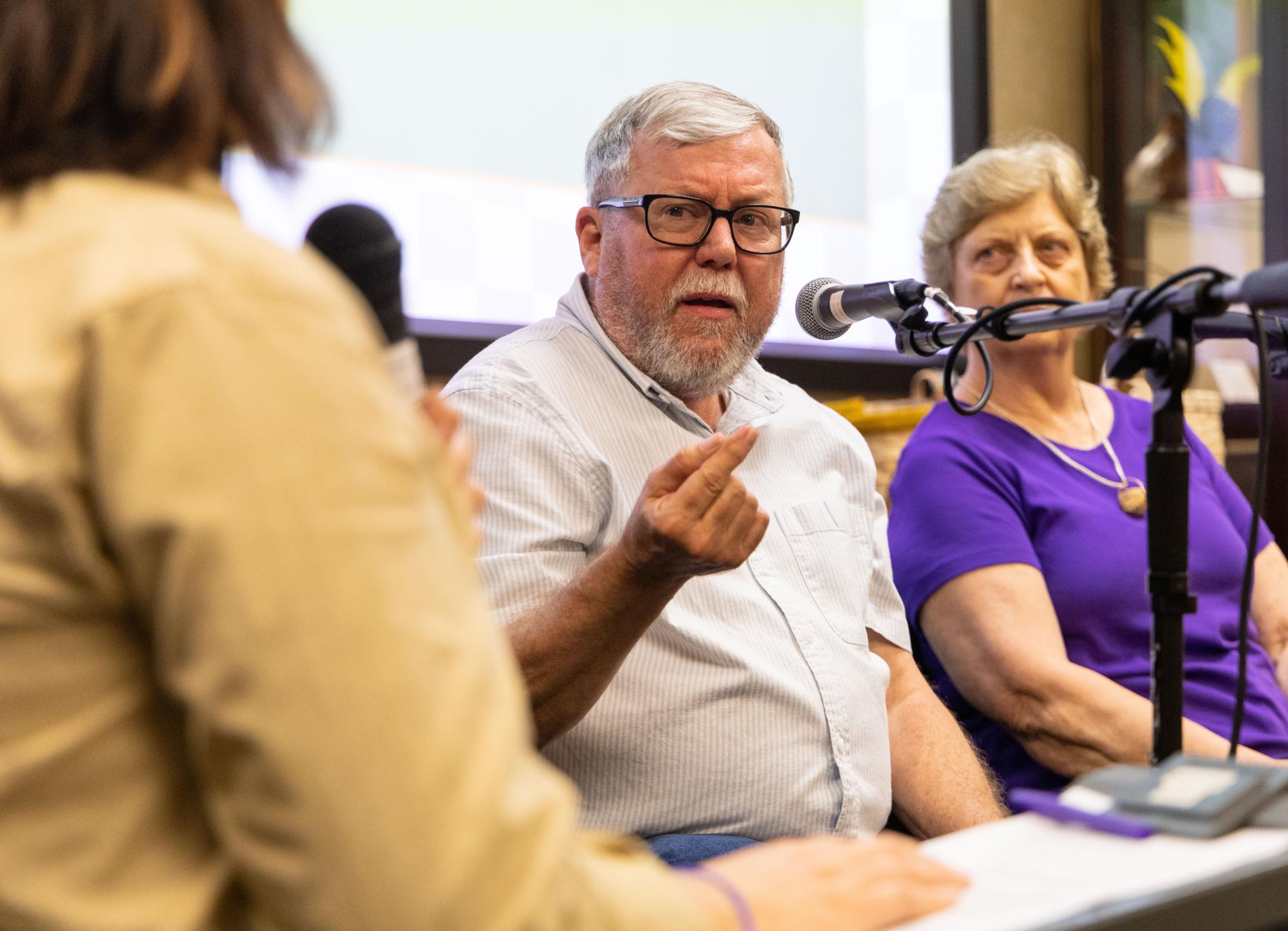The Kentucky Museum hosted the White Oak Gathering Reaching Beyond Tradition event on Thursday, Aug. 24 in collaboration with the Kentucky Folklife Program and the WKU Department of Anthropology and Folk Studies.
The event hosted several speakers, each of which had experience in basket making, who shared those experiences, along with how baskets could be used for a utilitarian purpose or for an artistic purpose.
Speakers included Mary Ann and Bill Smith from eastern North Carolina, formerly from Birmingham, Alabama, Sue Williams of Morrison, Tennessee, Scott Gilbert of Scottsville, Emily J. Swinney of Marshall, North Carolina, and Micah Wiles of Somerset.
“We really pride ourselves in documenting, conserving, presenting cultural heritage and traditional artists and artistry in and around Kentucky,” Camille Acosta, the Folklife Specialist with the Kentucky Folklife Program, said.
Acosta said the audience was able to learn about the evolution of basket making through a “topical narrative stage presentation.”
The presentations were scattered throughout the event, starting with the “Tradition-Bearers” presentation, which was held at 1 p.m., with Gilbert, Bill Smith and Williams presenting. The presentation allowed the audience to listen to stories about how they discovered basket making.
The next presentation, “Inspirations,” was held at 2:30 p.m., with Mary Ann Smith and Williams presenting their inspirations behind their weaving, through individuals and through the community.
“(Basket making), specifically in Kentucky, is a time-honored tradition that’s been around for quite a few decades now,” Acosta said. “I think what’s so brilliant about it is a lot of people don’t think it still exists, which is kind of a silly thought. When a lot of people think of basket weaving, (they think) it’s not modern, or it’s not contemporary, and that could be farthest from the truth.”
After a break for dinner, the next presentation, “Knowledge-Sharing,” was held at 5:30 p.m., with Bill Smith, Williams, Mary Ann Smith and Gilbert presenting the different roles that basket makers play in a community and how knowledge is shared amongst the public.
The last presentation, “Continuity and Evolution,” was held at 7 p.m., with Emily Swinney and Micah Wiles presenting younger generations’ engagement with the tradition-bearers, and how global communication can connect local practices.
Acosta said there are several basket making techniques that are local to the region, primarily due to the type of wood used in the process of making the basket.
“What I think is really cool is that it’s a tradition that has been kept alive with the people specifically here in Kentucky,” Acosta said. “(…) They keep it alive and keep it vibrant, and they use materials, driftwood, parts of White Oak trees in their actual basket making.”
The tradition of basket making has carried on through teachers and workshops, with several of the speakers having hosted or been a part of the workshops, Acosta said.
Acosta said these basket weaving classes and workshops had taken a hit from the pandemic, but that these programs have “morphed and changed,” along with preparing for future generations of weavers.
“Some people during the pandemic were hosting virtual online basket weaving workshops,” Acosta said. “(…) There’s a lot of brilliant up-and-coming basket weavers in these parts, and across the nation, and arguably, around the world. And I think that needs to be talked about more and celebrated more.”
Acosta said that she would want people to walk away from the event knowing how “beautiful and vital” basket making is, and that it transcends generations.

Beth Hester, a white oak basket maker, got into the practice along with her husband, Scott Gilbert, after having met Ollie and Lestel Childress, fourth and fifth generation basket makers from Park City.
“That’s how we learned about white oak, and prior to that, we had a basket that we inherited from Scott’s grandmother in east Tennessee,” Hester said. “It was made with white oak framework, but the weavers on that basket were honeysuckle vines, and so we made some baskets with white oak frames and honeysuckle vines for weavers, before we met the Childresses.”
Hester said her and Gilbert grew up in households that taught them how to do handwork, with Gilbert learning how to do woodwork from his father.
“For me, my maternal grandmother lived with us, and she and my mother did a lot of sewing,” Hester said. “They made our clothes, and crocheting, and knitting and things like that. Being the eldest daughter of the family, I followed in their footsteps, and loved to do knitting too.”
After having married Gilbert, Hester said that it was “a good fit” for them to become basket makers.
“Most of what I do these days are non-functional (baskets),” Hester said. “I like a variety of materials: white oak, willow, bark, and willow rods.”
Hester said that whether a basket is a work of art or a utilitarian tool depends not so much on materials, but what the owner of the basket intends for it.
“I think, as basket makers continue to work and as we learn from each other, we are looking to make the very best basket that we can make,” Hester said. “(…) There’s variety, perhaps more than a different way, but tradition is always evolving. Oftentimes, we think of tradition as something only coming from the past, but traditions evolve, and I think this panel we’ve had today, we are seeing how a tradition grows, and expands and develops over time.”
One idea that was at the event was that of a “basket family,” in which a connection is made between those that share in this tradition, Hester said.
“When I think of passing that knowledge onto someone else, I think of a connection that I’m making with that person, and that person’s making with me,” Hester said. “Perhaps that person is making connections with students, other teachers, we do feel that we are all tied together; we’ve called ourselves a family, we’ve called ourselves a tribe.”
Hester said that basket makers value what they are doing, what they learn from each other, and that is what connects them as a family.
“It’s alive, and it’s breathing, and it’s a really beautiful thing,” Acosta said.
Reporter Damon Stone can be reached out at [email protected].




